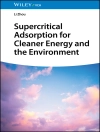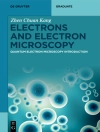Summarizes the fundamentals and significant advances of semiconductor-based photocatalysts for solar energy conversion.
Das E-Book Semiconductor Solar Photocatalysts wird angeboten von Wiley-VCH Gmb H und wurde mit folgenden Begriffen kategorisiert:
Chemie, Chemistry, Energie, Energy, Katalyse, Materialien f. Energiesysteme, Materials for Energy Systems, Materials Science, Materialwissenschaften, Photochemie, Photochemistry, Photokatalyse, Solar Energy & Photovoltaics, Solarenergie, Solarenergie u. Photovoltaik
Cuprins
Chapter 1: The fundamentals of solar energy photocatalysis
1.1 Background
1.2 History of solar energy photocatalysis
1.3 Fundamental principles of solar energy photocatalysis
1.3.1 Basic mechanisms for solar energy photocatalysis
1.3.2 Thermodynamic requirements for solar energy photocatalysis
1.3.3 Dynamics requirements for solar energy photocatalysis
1.4 Design, development and modification of semiconductor photocatalysts
1.4.1 Design principles of semiconductor photocatalysts
1.4.2 Classification of semiconductor photocatalysts
1.4.3 Modification strategies of semiconductor photocatalysts
1.4.4 Development approaches of novel semiconductor photocatalysts
1.5 Processes and evaluation of solar energy photocatalysis
1.5.1 Processes of solar energy photocatalysis
1.5.1.1 photocatalytic water splitting
1.5.1.2 photocatalytic CO2 reduction
1.5.1.3 photocatalytic degradation
1.5.2 Evaluation of solar energy photocatalysis
1.6 The scope of this book
Chapter 2: Heterojunction systems for photocatalysis
2.1 Introduction
2.2 Classification of heterojunction photocatalysts
2.2.1 Type-II heterojunction photocatalysts
2.2.2 p-n junction photocatalysts
2.2.3 Surface junction photocatalysts
2.2.4 Direct Z-scheme photocatalysts
2.2.5 S-scheme photocatalysts
2.3 Evaluation of the heterojunction photocatalysts
2.3.1 Band structure
2.3.1.1 Light absorption ability
2.3.1.2 Reduction and oxidation ability
2.3.1.3 Identification of major charge carriers
2.3.2 Charge carrier separation efficiency
2.3.2.1 Electrochemical test
2.3.2.2 Optical spectroscopy
2.3.3 Charge carrier migration mechanism
2.3.3.1 Metal loading
2.3.3.2 Reactive oxygen species trapping
2.3.3.3 In situ irradiated XPS
2.4 Applications
2.4.1 Photocatalytic water splitting
2.4.2 Photocatalytic CO2 reduction
2.4.3 Photocatalytic N2 fixation
2.4.4 Photocatalytic environmental remediation
2.4.5 Photocatalytic disinfection
2.5 Summary and Future Perspective
Chapter 3: Graphene-based photocatalysts
3.1 Introduction
3.2 Graphene and its derivatives
3.2.1 Graphene oxide
3.2.2 Reduced graphene oxide
3.2.3 Graphene quantum dot
3.3 General preparation techniques of graphene in photocatalysis
3.3.1 Chemical exfoliation
3.3.2 Chemical vapor deposition
3.4 General advantages of graphene
3.4.1 Conductor behavior
3.4.2 Photothermal effect
3.4.3 Large specific surface area
3.4.4 Enhancing photostability
3.4.5 Improving nanoparticle dispersion
3.5 Characterization methods
3.5.1 Transmission electron microscopy
3.5.2 Atomic force microscopy
3.5.3 Raman spectroscopy
3.5.4 X-ray photoelectron spectroscopy
3.6 Recent development in graphene-based photocatalysts
3.6.1 Metal oxide
3.6.2 Metal sulfide
3.6.3 Non-metal semiconductor
3.6.4 Metal-organic framework
3.7 Summary and concluding remarks
Chapter 4: Metal sulfide semiconductor photocatalysts
4.1 Introduction
4.2 General view of metal sulfide photocatalysts
4.3 Synthesis of metal sulfide photocatalysts
4.3.1 Solution-based method
4.3.1.1 Hydrothermal method
4.3.1.2 Solvothermal method
4.3.2 Chemical bath deposition
4.3.3 Template method
4.3.4 Ion exchange method
4.3.5 Other synthetic methods
4.4 Cd S-based photocatalysts
4.4.1 Crystal structures and morphology
4.4.1.1 Zero-dimensional structure
4.4.1.2 One-dimensional structure
4.4.1.3 Two-dimensional structure
4.4.1.4 Three-dimensional structure
4.4.2 Construction of Cd S-based nanocomposite photocatalysts
4.4.2.1 Cd S cocatalyst heterojunctions
4.4.2.2 Cd S-based type II heterojunctions
4.4.2.3 Cd S-based Z-scheme heterojunctions
4.4.2.4 Cd S-based S-scheme heterojunctions
4.5 In2S3-based photocatalysts
4.5.1 Crystal structure and electronic properties
4.5.2 Morphology of In2S3 photocatalyst
4.5.2.1 Zero-dimensional structure
4.5.2.2 One-dimensional structure
4.5.2.3 Two-dimensional structure
4.5.2.4 Three-dimensional structure
4.5.3 Construction of In2S3-based composite photocatalysts
4.5.3.1 In2S3-based type-II heterojunctions
4.5.3.2 In2S3-based direct Z-scheme heterojunctions
4.5.3.3 In2S3-based i
Despre autor
Professor Jiaguo Yu received his BS and MS degrees in chemistry from Central China Normal University and Xi’an Jiaotong University, respectively, and his Ph D degree in materials science in 2000 from Wuhan University of Technology. In 2000, he became a Professor at Wuhan University of Technology. He was a postdoctoral fellow at the Chinese University of Hong Kong from 2001 to 2004, a visiting scientist from 2005 to 2006 at the University of Bristol, and a visiting scholar from 2007 to 2008 at University of Texas at Austin. His current research interests are semiconductor photocatalysis for energy and environmental applications. He has published more than 600 papers in peer-reviewed international journals, and has been on the lists of Thomson Reuters/Clarivate Analytics Highly-Cited Researchers since 2014. He is Member of Academia Europaea (2020), Fellow of the European Academy of Sciences (2020) and Fellow of the Royal Society of Chemistry (2015). He is an Associate Editor of Chinese journal of Catalysis (since 2020) and Editor of Applied Surface Science (2014-2020), and serves on the editorial board of several international journals.
Professor Xin Li received his BS and Ph D degrees in Chemical Engineering from Zhengzhou University in 2002 and South China University of Technology in 2007, respectively. He joined South China Agricultural University as a faculty staff member, and became an associate professor of Applied Chemistry in 2011. In 2017, he became a Professor at the South China Agricultural University. During 2012-2013, he was a visiting scholar at the Electrochemistry Center, the University of Texas at Austin, USA. His research interests include photocatalysis, photoelectrochemistry, adsorption, and the development of nanomaterials and devices.
Dr. Jingxiang Low obtained his B.Eng (Hons) from Multimedia University, Malaysia in 2011 and master/Ph.D. degree from Wuhan University of Technology in 2018. He is currently working at University of Science and Technology of China. His research interests include the design, synthesis and fabrication of photocatalytic materials for energy and environmental applications. He has published more than 35 papers in renowned journals including Chemical Reviews, Advanced Materials, Journal of the American Chemical Society, etc., with total citations over 10, 000 times (H-index: 26). He has won CAS President’s International Fellowship Initiative, 2017 top 100, 000 ranked scientists (PLOS biology) and China’s 100 most influential SCI papers.












